Freshmen have been excluded from these previews, as we'd like to wait and see what they have to offer on the NCAA level before we come to any long-term conclusions.
-Top 20 Prospects in the Big Ten
-Top 25 Prospects in the ACC
-Top 15 Prospects in the Big 12
#1 Terrence Ross, 6'6, Sophomore, Shooting Guard, Washington
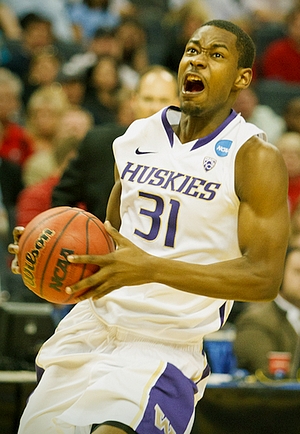
Matt Williams
Terrence Ross may have only scored 8 points per-game last season, but isn't hard to understand why scouts are high on the rising sophomore. Despite playing a limited role for the Huskies, the Portland native showed a truly impressive blend of size, athleticism, aggressiveness and scoring instincts that should help him fill the void left behind by the departure of Washington's top-three scorers and raise his profile as a NBA prospect.
Ross's upside at the NBA level begins with his excellent physical tools for the shooting guard position. Standing 6'7 (albeit with an average wingspan), the former top-35 recruit looks the part of a pro swingman. A high-riser with a tremendous first step, he also possesses prototypical athleticism for the wing position, which he's already shown the ability to use effectively from the perimeter and around the basket. Ross may need to add some weight to his frame to help prepare his body for the rigors of the NBA, but it is hard not to be impressed with what he brings to the table physically.
On top of his athleticism, Ross possesses a very promising skill set. At this point in his career, he is, in a word, aggressive. He operates on the floor with the moxy of a player with unlimited confidence, never being shy about pulling the trigger from the perimeter, at times to a fault. Despite his athleticism, Ross settles for a large number of fade-aways and contested shots from the outside, with more than half of his total shot attempts coming from beyond the arc, despite converting just 35% from that range.
Though there are concerns about his shot selection, it is Ross's ability to knock down tough shots that makes him an intriguing prospect. Though he needs to shore up his consistency and decision-making, Ross displays a fluid shooting stroke with good elevation and a reliable release point. If he continues to work on his skill-level, he could develop into a very effective offensive threat.
Ross may have knocked down some big-time shots as a freshman, but he was at his best using his athleticism at the basket. The Huskies ran more than a few set plays to free up Ross for backdoor lob passes and the talented guard earned himself some easy buckets by getting up the floor in transition and cutting to the basket. An explosive leaper, Ross can finish plays above the rim when he has any sort of space and is capable of finishing acrobatically around defenders as well. Converting 63.8% of his finishing opportunities according to Synergy Sports Technology, Ross backs up his style with substance.
As Ross matures as a player, there are a few things he could do to improve his stock, the most obvious of which would be utilize his athleticism more effectively to create high percentage shots off the dribble and get to the foul line. Ross is not a polished ball-handler, and doesn't look entirely comfortable going left, but he is more than capable of creating separation and beating his man to the rim with his first step and flashes an impressive crossover from time to time.
Attempting just 2.1 free-throw attempts per-40 minutes pace adjusted last season, the lowest rate of any player in our top-100 prospect rankings, Ross' efficiency would improve greatly if he focused more on creating high percentage shot opportunities around the rim instead of just settling for the first available jumper.
Away from the basket, Ross would benefit greatly from improved catch-and-shoot consistency. He's capable of making things happen from the perimeter with his raw shot-making ability, but needs to make the most of the easy opportunities he sees within the flow of the game. He is not yet a lights out shooter when left openmaking just 32% of his attempts with his feet set last season-- and would become a true matchup nightmare if he improved his consistency in this area over time.
As we've mentioned in the past, Ross's potential doesn't end on the offensive end. His wingspan and lateral quickness give him terrific upside on the other end of the floor as well. As a freshman, he had some good moments, making a number of plays in the passing lanes and using his average length very effectively to contest shots out on the perimeter and pull down rebounds.
Against more aggressive slashers, Ross struggled at times, allowing ball-handlers to beat him to spots by being a bit too aggressive. With added strength and another year of seasoning, Ross is capable of doing a better job denying penetration as a sophomore, and while he seems much more apt to expend his energy on the offensive end, has the potential to be a rock solid defender in time.
With incoming freshman Tony Wroten and Abdul Gaddy set to handle the point guard duties, Ross and C.J. Wilcox will round out a deep Washington backcourt. While he won't be shouldering the load himself, this season is an opportunity for Ross to take a step forward in his development and showcase the facets of his game he didn't get the opportunity to display last season.
The NBA is littered with wing players who are either prolific shooters or effective drivers, but rarely do you find prospects that can do both. Ross has the physical tools and scoring instincts to develop into a complete scorer if he continues to work on his skill-level and improves his knowledge of the game.
If Ross continues to make shots at a high level and rounds out some of the rough edges of his game, he could be on the verge of a break out year. While clearly still in an early stage of his development, Ross is one of the most interesting young wing prospects for NBA scouts to follow in college basketball.
#2 Joshua Smith, 6'10, Sophomore, C, UCLA
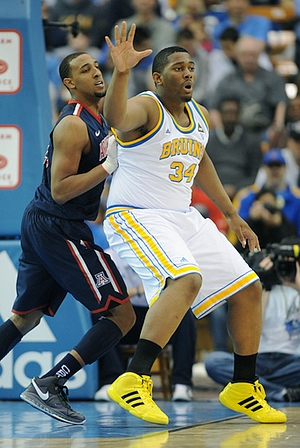
Derek Bodner
Standing 6'10 and listed generously at 305 pounds, Bruins center Joshua Smith provides an intriguing skill set, but still has a considerable amount of work -- both in terms of shaping his body and his basketball skill -- until he can untap his full potential.
Smith is, first and foremost, a post scorer. He is a tough cover for any collegiate big man in the paint, using his massive frame, incredible strength, and touch to score over defenders at this level. Smith does a great job of establishing deep position in the post almost at will, has terrific hands to catch entry passes and improving footwork.
Smith is, at this point, mostly a below the rim player when finishing in traffic, although this could change if he's able to shed the considerable extra weight he's still carrying. He shows an effective right handed hook, although hasn't developed a similar move with his left hand, limiting him somewhat when going over his right shoulder.
He shows potential as a passer out of the post, although at this point it's somewhat unrealized. Smith does a good job of not holding onto the ball too long and passing before being trapped by the double team, but his recognition and ability to make the right pass isn't fully developed, and he can become turnover prone. With more experience, better spacing and a more consistent perimeter shooting team around him this could be an area that sees improvement down the line.
Outside of post scoring, the majority of the rest of Smith's offense comes from offensive rebounding, where he is among the best in the nation. Smith pulled in 6.3 offensive rebounds per 40 minutes pace adjusted last season, which ranked second amongst all prospects behind only Kenneth Faried. His combination of bulk, length, effort in establishing position and soft hands makes him a constant threat to crash the offensive glass.
The rest of his offensive game is a clear weakness at this stage. Smith provides virtually nothing beyond 10 feet, and in fact, according to Synergy Sports Technology had only attempted 6 jump shots all year. No pick and roll or pick and pop sets are run for him, and he doesn't have a face-up game at all. At this stage in his collegiate career he's able to be a very effective offensive player off of post-ups and offensive rebounds alone, but in order to take the next step as a prospect will need to develop this part of his game further.
That effort he gives on the offensive glass, unfortunately, doesn't apply to the defensive side of the ball, as his 5.2 defensive rebounds per 40 minutes pace adjusted placed him second to last amongst centers in our top-100 rankings. His technique and effort boxing out was inconsistent, and he doesn't have the mobility to make up for it.
While far more nimble on his feet than one might suspect just by looking at him, his overall athleticism is still a question mark, and will be an issue as he's asked to defend away from the basket more. He gives considerable space to the ball handler on pick and rolls, although some of this may have been an adjustment to try to keep him out of foul trouble, he ranked as the most foul prone player amongst our top-100 prospects last year. Foul trouble will likely continue to be a problem for Smith at his current size.
Smith doesn't look to be a weakside shot blocker, at least not in his current build, but he is a solid positional defender, doing a solid job at denying post position early, being able to hold his ground defensively and block shots with his length.
Smith clearly has a considerable amount of natural basketball talent and athletic ability, but he will need to lose a considerable amount of weight to fully utilize it, particularly at the next level. If he is able to do that and judging by recent reports, that's a big if -- he presents an intriguing skill set, and one that's hard to find.
#3, Andre Roberson, 6-7, Small Forward/Power Forward, Sophomore, Colorado
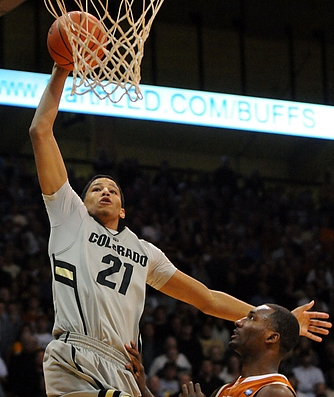
Walker Beeken
A late signee who was not considered a top-100 prospect by any of the major high school scouting services, Colorado's Andre Roberson played 22.4 minutes per game as a freshman for the Buffaloes and led the team in rebounds, steals, and blocks per game while playing a minimal role offensively. With the departures of leading scorers Alec Burks and Cory Higgins, Roberson should have more opportunity to showcase his offensive talents and seems poised for a breakout season.
The intrigue with Roberson as an NBA prospect begins with his outstanding physical tools. The son of a professional basketball playing father and a mother with a volleyball background, three of Roberson's sisters were Division I NCAA athletes. Standing at 6'7 with a long, lean frame that looks like it should continue to fill out in time, he looks the part of an NBA small forward. On top of that, he's an extremely fluid, explosive athlete who enhances his physical gifts by playing with great energy.
This was clear from his impact on the boards as a freshman. He averaged 13.5 rebounds per forty minutes pace adjusted, an incredible rate for a player his sizeidentical to Kawhi Leonard last season. Roberson often flew in from the perimeter and grabbed rebounds over the top of players, and was often used out of position at power forward, thanks to his abilities to compete on the glass with most big men.
A big key to Roberson's success this season will be how well he can adapt to more of a featured role offensively. Never considered much of a scorer even in high school, he didn't really have any shot-creating or playmaking responsibilities as a freshman. He'll likely get more a chance to display that part of his game this season, which will play a major factor in determining just how much upside he has to tap into down the road.
Regardless of how he progresses in that area, he already brings quite a bit to the table with his athleticism, length, and energy, which make a terror in transition, cutting to the basket, and creating extra possessions with his offensive rebounds. He's a tremendous finisher at the rim and was very efficient with his touches last season, converting an outstanding 64% on his 2-pointers last season.
Roberson isn't a great shooter at this stage, but he did show some promise, knocking down a respectable 37% of his jumpers last season, including 34% from behind the arc. He didn't look particularly fluid in his limited attempts shooting off the dribble, but looked more comfortable with his feet set. Becoming more of a reliable catch-and-shoot threat from the perimeter would be a big boost for his NBA stock, and he seems capable of improving if he puts in the work, despite the fact that he only converted 55% of his free throws last season.
Robertson's physical tools also manifest themselves on the defensive end, where he's capable of defending almost any player on the floor at the college level. He defended mainly power forwards last season, but he has the look of the prototypical stopper on the wing at the NBA level with his size, length, and ability to cause chaos on the ball and get out into the passing lanes, as well as challenge shots at the rim.
Though it is too early to draw many conclusions on Roberson's NBA prospects after just one college season in a minimal role, it is clear that he possesses quite a bit of upside, and will be a player that scouts will be keeping an eye on. This season should shed more light on how his offensive game is developing and just how much potential he has down the road.
#4 Dwight Powell, 6-9, Sophomore, Power Forward, Stanford
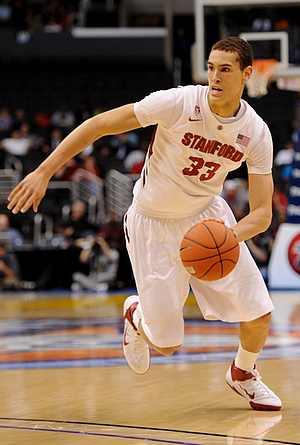
Jonathan Givony
Arguably the most important recruit in head coach Johnny Dawkins' tenure at Stanford thus far, Dwight Powell came into college with huge expectations of turning around a program that has stagnated somewhat in recent years.
A little old for a sophomore (he turned 20 in July), Powell started playing basketball later than most, picking up the sport in Canada when he was 14 years old.
A mobile big man with a nice frame that is still a ways away from filling out, Powell shows good quickness and fluidity for his position to go along with solid size and length.
Besides his athleticism, Powell shows an intriguing skill-level as well as a good feel for the game. He was not the focal point of Stanford's offense, but was able to show flashes of talent in a variety of different areas and has a nice upside to grow into as his frame fills out.
Where Powell looks most comfortable right now is on the perimeter. He can put the ball on the floor nicely, utilizing shot fakes and beating his man off dribble impressively with a good first step and notable ball-handling skills, even if he can't always finish what he creates around the basket due to his lack of strength. He got to the free throw line at a decent rate last season, and converted a solid 68% of his attempts once there.
About 1/3rd of Powell's field goal attempts came on jumpers, but he was very inconsistent in this area, converting on just 26% of those shots, including 7-25 from beyond the 3-point line. Powell shows very nice shooting mechanics and should be able to develop into a capable floor-spacer in time, but he certainly wasn't a dangerous threat last year. This upcoming season should give us a better sense of Powell's potential in this area, something that will play a big part of his pro evaluation eventually.
Inside the post, Powell doesn't have much of a post game to speak of at the moment, as he just does not possess the lower body strength needed to establish deep enough position to get high percentage shots off. His hands, footwork and touch all show great potential, but he'll need to become a little tougher and scrappier to take advantage of his size closer to the rim. At the moment, he much prefers to sag out onto the perimeter.
Defensively is where Powell might be the furthest from being able to see serious playing time in the NBA right now. He struggled badly trying to keep opponents out of the paint as a freshman, getting backed down and pushed around at will, and not showing great toughness fighting back. Foul trouble hampered him in many of Stanford's contests, as he committed four or more fouls in 13 of their 31 games last season.
He was similarly ineffective out on the perimeter, as his fundamentals and awareness are just average, which is something he'll have to work on down the road. He's very mobile for a player his size, but lacks significant experience.
Powell didn't contribute much as either a rebounder or shot-blocker eithersomething he should be able to do more of in the future considering his physical tools.
All in all, Powell's freshman year was definitely a learning process, as the transition from high school to college was not a seamless process, even if he did show some intriguing flashes from time to time.
Nevertheless, he shows very good potential to continue to improve down the road, as he possesses a rare combination of size, fluidity, skills and feel for the gamealbeit in a pretty raw package at the moment.
How his body fills out as he continues to mature physically will likely dictate the type of strides he's able to make over the next year or two. It may take some time as we've seen in the past from players in his mold, but the end result could be very much worth waiting for.
#5 Allen Crabbe, 6'6, Shooting Guard, Sophomore, California
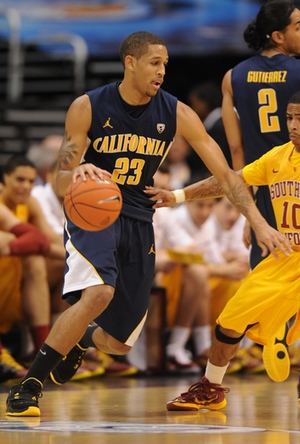
Kyle Nelson
Allen Crabbe started his freshman campaign slowly but saved his best for last, emerging as Cal's primary option down the stretch and leading the Golden Bears to an NIT-bid. Crabbe averaged 19.8 points per game over his final six games and was named the PAC-10 Freshman of the Year.
Though Crabbe has excellent size for the shooting guard position at 6'6, he must continue to improve his skinny 205-pound frame. He is just an average athlete, as well, and lacks great quickness and explosiveness, which makes getting stronger essential to his draft prospects.
Explosiveness does not factor significantly into Crabbe's offensive game at the moment. As a freshman, he was a perimeter-shooting specialist, with 80% of his shot attempts coming on jumpers. Nevertheless, he was very effective in this role, connecting on 40% of his 5.9 three-point attempts per game. His mechanics are consistent, especially when he is shooting with his feet set, and his range extends well beyond the NBA three-point line. At this stage, Crabbe is most effective as a spot-up shooter, but he should only continue to develop his game off of the dribble and inside of the arc as a sophomore.
Crabbe's game inside of the arc is a mixed bag. He is at his best in transition, where his superior instincts and shooting touch allow him to finish with relative ease.
Though he does not often journey into the lane in the half-court offense, he does show potential as a slasher. While getting stronger would obviously help him better finish in the lane, so too would improving his handles. His first step is just average, but his body control and shooting touch allow him to be an above average finisher around the basket. He struggles to finish through contact, though, and rarely gets to the line, which is evidenced in his 3.4 FTA per 40 minutes pace adjusted.
Despite the weaknesses that he displayed as a freshman, Crabbe's instincts and feel both look well above average, suggesting that he will develop further as he continues to mature. His passing abilities are intriguing and he even had chances to run the pick and roll to mixed results as a freshman. That being said, he should work to improve his decision making, minimizing bad passes and playing to his strengths.
While Crabbe definitely needs to get stronger to improve as a defender at any level, he showed nice potential as a freshman. Though his lateral quickness is average and he needs to work on his fundamentals, his general effort is good and he uses his length to bother his man. Whether or not he'll be able to guard shooting guards at the next level remains to be seen, however, and is worth watching during next year.
Ultimately, while Crabbe emerged as the best freshman in the Pac-10, he still has a long way to go before becoming a legitimate NBA prospect. Maximizing his strength and athleticism is essential as he continues to develop his game because scouts will want to see if he can contribute to a team outside of his spot-up shooting abilities. Cal returns a solid core of talent that is ready to build on last year's success and Crabbe will be a significant factor.













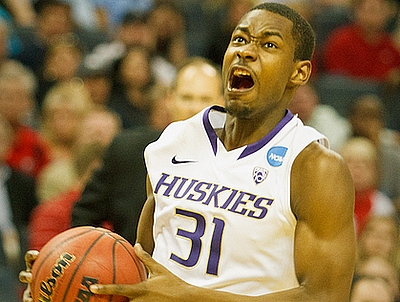



























Comments